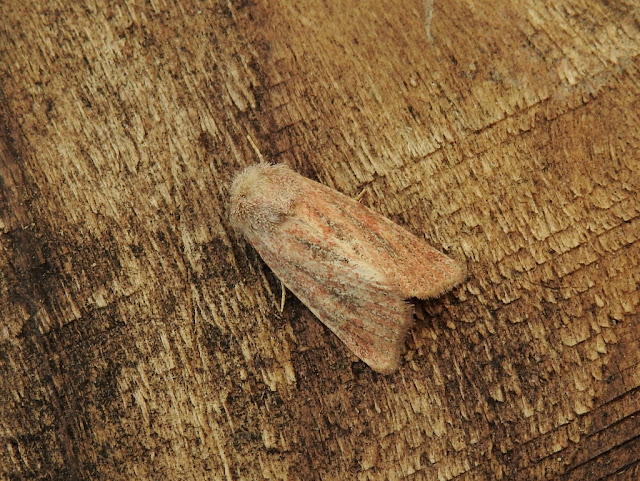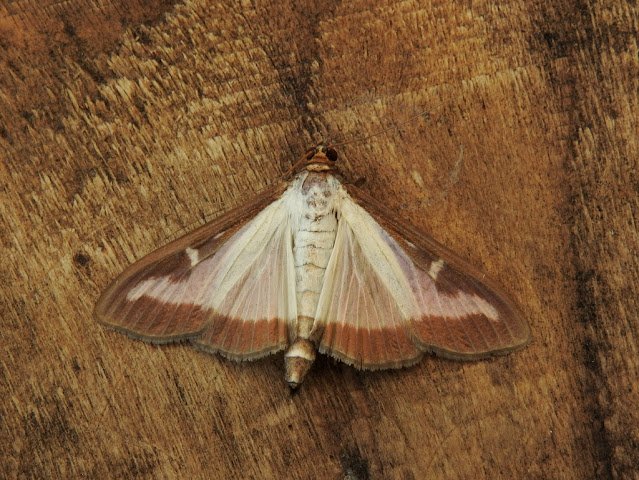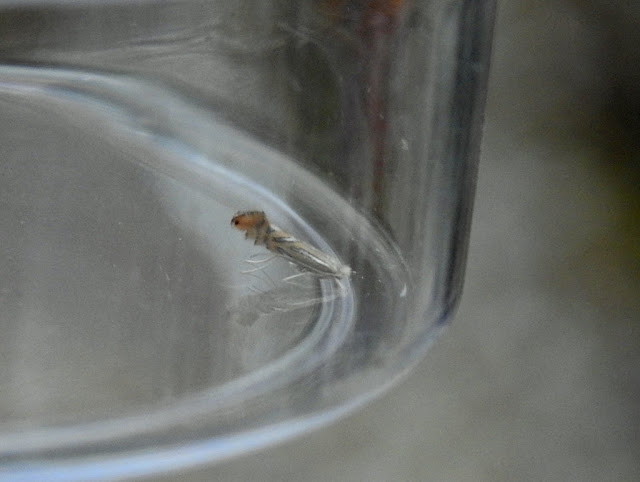Scanning the plates in a moth field guide is like sifting a massive tin of
sweeties. So many delicious temptations. One which has appealed since I first
noticed it is Scallop Shell. Scallop Shell isn't one of those
ludicrous pink and purple jobs from overseas, but nothing in the book has more
zig-zag stripes. It looks gorgeous. And on Wednesday night I caught one. Not in
the trap, but on the cabin wall, during a 'trap monitoring' session...

|
Scallop Shell, reluctantly posing on the moth plank...
|

|
...and on the deck, after storming out of the studio like a prima
donna.
|
I am learning that some moths are very relaxed about photography (especially
after a spell in the fridge) whereas others are very much not, and leg it at
the slightest provocation. Scallop Shell falls into the second
category.
A few more from Wednesday night...

|
I think I have the measure of Currant and
Wormwood Pugs now. At least I hope so.
|
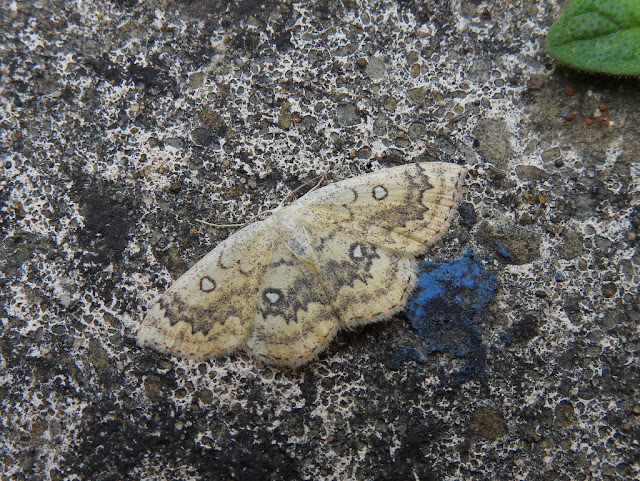
|
Another beautiful little Mocha. Like the two above, escaped from
the studio with rapid ease.
|

|
Couldn't resist a few snaps of our second Rosy Minor.
|

|
A striking line of 'stitching' along the wing edges.
|
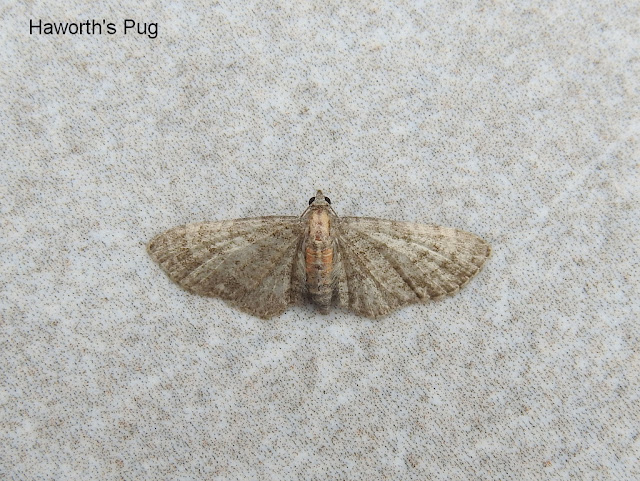
|
We seem to do well for pugs. I'm pleased about that, because I like them
a lot.
|

|
Also known as Willow Ermine, there are several species which look
very similar, but I am going to stick my neck out. That isn't shadow on
the wing, but a smoky grey wash. Subtle, but along with the relatively
large size of this one, a useful ID feature.
|
As alluded to in the last caption, there are many moth species which basically
cannot be told apart by eye from one or more look-alikes. I find this quite
frustrating, but can't do much about it. The glossy little micro in the next
pic is a good example. It has a twin. However, on balance it is far more
likely to be one than the other, so I'm having it. I expect this is not the
purist's way, but hey-ho...
So Wednesday night was great. Some classy moths (including four new species) and a lot of excellent ID challenges. However, by now I was pretty knackered. Thankfully I was going to get Thursday night off. Sandra and I were babysitting our granddaughters over in Lyme Regis, so hopefully I was in for a proper night's sleep at last.
About an hour before we headed over, I thought to myself: 'Why not take the trap with us? It will be interesting to see what Baz and Abi might get in their garden. I can just switch it on and forget it until whenever the girls wake...'
Ah, so naive.
I switched it on, yes. But how could I just forget it? Of course I must trot out there and have a look occasionally. And a good thing too, because I caught another Scallop Shell! This one on the outside of the trap. Even so, just a handful of quick checks and I was in bed before midnight. But I couldn't resist setting the alarm for 6am...
The pre-bed checks hadn't been that promising. Very little activity generally and, apart from the Scallop Shell, no notable moths. But you never know...
Because I am a beginner, there are very few rare moths that I would instantly recognise for what they were. Death's Head Hawk-moth is one of course, but it is on a very, very short list. In by far the majority of cases I would probably know that I was looking at something I had not seen before, so would simply pot it up anyway. If it turned out to be a rarity, well, great, but any rarity buzz would very much be after the fact. However, about three egg trays in to this morning's catch, my blurry eyes alighted upon a moth that actually was on that very, very short list...
'Strewth! Is that what I think it is? Surely not?!'
At this point I enjoyed what can only be described as a mild dose of the shakes. I recognised it from those few and far-between moments when birding is good enough to provide one. Trouble is, the shakes are not helpful when it comes to potting a moth. On Tuesday morning I witnessed a very experienced and expert moth-er totally fumble the potting of a rarity, and then watched a Splendid Brocade disappear over the horizon. Thankfully though, no such disaster, and the moth was mine. I shut the trap, got the book out and checked my hunch, half expecting to be wrong. But I was not wrong.
Okay then, let's see what else we have.
Another couple of trays, and then...
'What?!! Another one??!!'
More shaking, more hairy moments with a plastic tube. Then, at 6.30am, this photo...
 |
Orache Moth x2. A pukka mothy rarity.
|
Later, in more leisurely, and less fraught, fashion...
 |
The brighter and fresher of the two
|
It is more than likely that this will never happen to me again, so forgive the mild self-indulgence, photo-wise. In real life, up close, this moth is even better than the photos suggest. All green moths are amazing, but Orache Moth is on a different level. Stunning is an over-used word, but exactly the right one here.
I'm not sure how many Dorset records of Orache Moth there have been, but I am probably right in thinking less than 20. Which gives a bit of context to two in the same trap.
The...er...also-rans...
 |
Dwarf Cream Wave (new, but it wasn't my garden, so, er...)
|
 |
Scallop Shell. I simply could not coax it any further on to the Hazel leaf. Next time I touched it...gone.
|
 |
Clay (new, but...as above)
|
 |
Wormwood Pug. Always look at pugs.
|
 |
Cydia splendana. About 8mm of beautifully intricate markings.
|
 |
Shuttle-shaped Dart (new, but..etc...)
|
Two Orache Moths in one night, for a rank beginner, is just ridiculous. I fully appreciate that this is probably a once-in-a-lifetime kind of thing, but cannot avoid the feeling that the moths are doing a number on me...
Further, Gavin. Further. Onwards down the dark path...













































